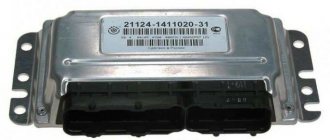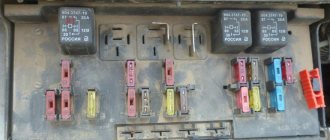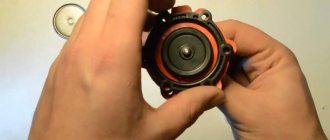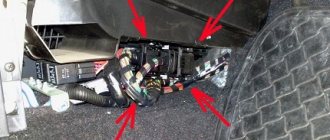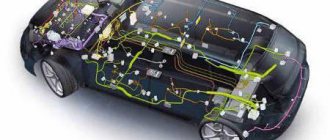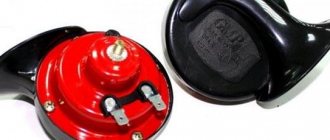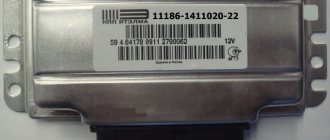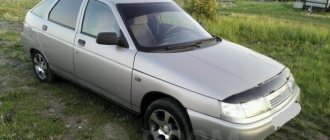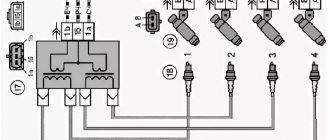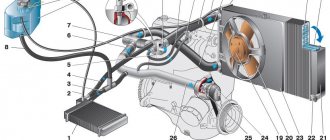Download PDF
Any car owner should know how to check the engine control unit.
It contains too many different sensors, the main task of which is to optimize the operation of different components and their harmonious interaction with each other. If the harmony is disturbed, at a minimum you will lose speed, maneuverability, service life of spare parts, fuel consumption - and, ultimately, money. At most, at a certain stage your car simply won’t start. How to check the engine control unit? In principle, it is not very difficult, even if you are not very friendly with electricians. You just have to push yourself a little. In any case, if you suspect the ECU is not working correctly, the service station will not simply take it for repair - you will have to clearly outline your complaints.
Causes of errors issued by the ECU
The simplest option is for the conductor to fly. If this is the case, breathe a sigh of relief: having “ringed” the control unit and found out which one, you can replace it (often yourself). In any case, craftsmen won’t charge much for most of them. It's much worse if the firmware is broken.
There have been cases when the owner, locked tightly in a car, was taken to a service station by a tow truck. You won't be able to reflash the microprocessor yourself - unless, of course, you are an expert in this area. So checking the engine control unit is in your own interests: in the initial stages of a software failure, such disasters do not occur, and in the future they can be prevented in time.
Algorithm of actions to restore ECU operation
To repair the engine ECU, the following operations are needed:
- Find the location of the breakdown.
- Re-measure the resistance.
- Find the conductor attachment points.
- Attach a wire with the required resistance in parallel using a soldering iron; it is recommended to leave the old wire in place.
After the measures taken, the system should work stably. If ECU errors recur, you must contact a service center.
The service life, safety and reliability of the vehicle depend on the timely repair of the engine control unit.
Procedure
The only thing you will need is a multimeter and a wiring diagram for the unit. The first one will have to be purchased (it is not included in the package of cars of all brands), and the latter must be included in the documents supplied with the car. You will have to study the diagram carefully. If the ECU does not produce random data, but points to a specific block, find it on the diagram and begin to “ring” it.
If accurate data is not available, the entire system will have to be checked. Having found a breakdown, measure the resistance again and determine where exactly the wire is attached. Parallel to the old one, without removing it, solder a new one with the same parameters. If this is the problem, it should work. If it doesn’t help, the block or some part of it may have fallen off. In this case, sighing heavily, stomp to the service station.
Where is the ECU located on the VAZ 2114
In a VAZ 2114 car, the control module is installed under the center console of the car, in particular, in the middle, behind the panel with the radio. To get to the controller, you need to unscrew the latches on the side frame of the console. As for the connection, in Samar modifications with a one and a half liter engine, the mass of the ECU is taken from the power unit housing, from the fastening of the plugs located to the right of the cylinder head.
Location of the VAZ 2114 ECU
In cars equipped with 1.6- and 1.5-liter engines with a new type of ECU, the mass is taken from the welded stud. The pin itself is fixed on the metal body of the control panel near the floor tunnel, not far from the ashtray. During production, VAZ engineers, as a rule, do not securely fix this pin, so over time it can become loose, which will lead to the inoperability of some devices.
Practical advice
To avoid such difficulties, you should take care of the engine control unit in advance. Remember: electronics are delicate things, and they are susceptible to dust, temperature changes, and moisture. If you value your four-wheeled horse, learn the block diagram like a multiplication table, and call him at the slightest problem. It doesn’t show fuel consumption - you can live without these indicators (some people manage to estimate it by mileage). However, the failure of this sensor may foreshadow more severe problems to come.
If you already know how to check the engine control unit, do not be lazy to use your skills. Preventive measures can prevent major problems and significant costs.
The ECU is an electronic engine control unit, essentially one of the main components in the car; people call it the brains. If there is something wrong with the brains, then the car engine will not work normally, so you need to repair the engine brains as quickly as possible.
Today we will talk about the reasons why the ECU fails, as well as how to diagnose the ECU yourself and what equipment is needed for this.
How the processor part works
The basis of the processor part of the ECU is a single-chip microcomputer (microelectronic computer). In fact, this is the very “brain” of the electronic engine control unit. By modern standards, a microcomputer is designed quite simply. The fact is that its key elements are included in a structure that fits on one crystal (chip). An important point in describing a microcomputer is its capacity. Bit capacity refers to the number of bits of information that the microprocessor will operate with. There are microcomputers 8-
,
16-
and
32-bit
. The devices themselves include:
- Central process;
- Read-only memory (abbr. ROM);
- Analog-to-digital converter (abbr. ADC);
- Random access memory (abbr. RAM);
- Input and output ports;
- Clock generator;
- Timers, otherwise called counters.
A parallel can be drawn between a modern computer and the processor part of the ECU. In fact, the ECU combines a number of components that go separately from each other in the system unit of personal computers and laptops, but are combined by the motherboard
There are interesting features here, but we will not consider them - it is important for a car enthusiast to understand that the circuit diagrams of modern electronic computers are very similar to each other
The central processor of the computer selects commands and data from memory and performs various operations on this data. In addition, it controls signals passing through the internal address and data bus. Read-only storage is where programs and data are stored. The information is in the form of constants. The program itself is written in the form of microcomputer machine codes. The data are calibration tables of constants involved in the calculation process. Data from tables can also be selected as control parameters. Interestingly, data in ROM is stored indefinitely
. Random access memory takes on the task of storing data that may change. For example, intermediate results of calculations or values received from sensors. RAM can store information for a limited period of time - it is erased after the power is turned off.
The tandem central processor - ROM - RAM is key
for ECU. To put it simply, it is this tandem that selects data and parameters, calculates them, remembers them and issues commands. This tandem can also include the so-called non-volatile RAM. They are powered directly from the battery. Such memory can record data and store it for a very long time. As long as the battery does not lose stored energy due to self-discharge, non-volatile RAM will continue to store data.
An important element of the ECU is the analog-to-digital converter. The fact is that single-chip microcomputers can only work with digital signals. The ADC converts the analog signal into digital code
. Input and output ports, as you might guess from their names, are used to receive and read input signals and transmit output signals and information. A timer is a device that serves both to measure time intervals and count the number of events. The clock generator is designed to synchronize the operation of the entire system by generating clock pulses. The accuracy of measuring time intervals will depend on the accuracy of the generator.
The most common causes of ECU failure
Every modern car uses a huge amount of electronics, and as we know, electronics fail over time. But what is eternal in this world? But according to statistics, brains fail quite rarely.
The most common cases when brain repair is required are:
- after a strong impact, the ECU may be damaged, that is, cracks may appear in the boards;
- if the engine overheats, then there are cases when the brains also fail due to temperature changes;
- the appearance of rust if moisture gets into the motor control unit housing, which happens quite rarely;
- and also, the cause of ECU breakdowns may be incorrect chip tuning;
- brains can be damaged if you light another car while the engine is on;
- Also, the cause of ECU failure may be incorrect connection of the battery.
These reasons may not cause much harm to the control unit, but may immediately damage the brain.
But it is possible to do a brain diagnosis, this will save the ECU from damage, of course, it all depends on the specific case. It is advisable to diagnose the ECU once a year or during each maintenance. Because repairing the brain is a fairly expensive procedure, and a new control unit generally costs a lot of money.
Trouble the engine: a simple way to check the ignition coil control keys
Troubles the engine
- this is a very common problem with injection cars, one of the reasons for this is this.
But how can you determine that the control unit has actually failed and not some other system? This can be understood by a number of the very first signs that may appear in such a situation:
1. Presence of obvious physical damage. For example, burnt contacts or conductors.
2. Inoperative control signals for the ignition system or fuel pump, idle mechanism and other mechanisms that are controlled by the unit.
3. Lack of indicators from various system monitoring sensors.
4. Lack of communication with the diagnostic device.
How to check the ECU in your garage
Even a non-professional can handle brain diagnostics, because all brains come with a self-diagnosis system, which is already built into the control unit.
The engine control unit is a kind of computer that processes signals from sensors and interacts with other systems in the car.
The most popular brains that are used in many modern cars are Bosch M 7.9.7. In order to diagnose the ECU, you need to connect to it using a laptop or tester. The laptop must have a program. ,
For diagnostics, you can use the KWP-D program, which is free; you also need an adapter that supports the KWP2000 protocol. To do diagnostics, you need to connect the adapter - insert one end into the laptop, the other into the ECU port. Next, you need to turn on the ignition and turn on the program. Then a message will appear stating that the diagnosis has started and a table with important vehicle parameters should appear.
Errors that are issued from the motor are located in the DTC section. If errors are found, then you need to go to the “Codes” section, where the error codes will be visible. If there are no errors, then everything is fine with the motor.
You also need to look at other sections, there is data about the battery, throttle position, etc.
For those who are concerned about increased fuel consumption, you need to monitor the QT parameter, it is he who talks about fuel consumption. During idling, this section should contain the following numbers: 0.6 - 0.9 l/hour. You also need to check the LUMS_W section, which is responsible for the crankshaft during rotation; if its value is more than 4 rpm, this means that the mixture in the cylinders is ignited unevenly. Therefore, it is necessary to check the voltage in the spark plugs, as well as the spark plugs themselves and the high-voltage wires.
Self-diagnosis
You can determine some ECU malfunctions yourself. Or at least understand whether he is showing “signs of life.” This is also possible thanks to the self-diagnosis system that almost all control units have. If a car enthusiast wants to carry out independent diagnostics, he will need a special tester or a computer with a pre-installed program. It will be easy to find on the Internet. In addition, you will need an adapter. Here's what to do:
- Connect the adapter to the USB port of the computer and to the output of the electronic unit;
- Turn on the ignition (it is not necessary to start the engine itself);
- Run the previously downloaded and installed diagnostic scan on your computer;
- Watch for a message to start diagnostics to appear on the screen. If it is not there, check the connection is secure;
- Go to the DTC section (may have a different name depending on the program) - it contains the codes of all faults. The codes are encrypted, and you can decipher them in the same program or using data from the technical documentation for your car.
Unfortunately, there are times when the computer cannot be connected to the unit. In this case, the car enthusiast will need an oscilloscope, a cable and specialized software. It’s not difficult to find the necessary software, but with an oscilloscope
may have problems. Next, diagnostics will need to be continued using a tester or multimeter. The car enthusiast will have to carefully study the electrical circuit of the controller and measure the resistance. It is best to turn to specialists, but if the car enthusiast is well versed in electrical engineering and has a lot of time for diagnostics, he can identify the problem on his own.
Other devices for checking ECUs
To diagnose the brain, you need to buy an oscilloscope, which will show all the necessary information about all the components in the car.
The price of an oscilloscope is within 5,000 rubles, but you will also need a motor tester, which is designed to diagnose the motor; its cost does not exceed 3,000 rubles. With its help, you can determine why the speed drops and other problems with the engine occur.
And then a video about how to pass Bosch ECU 7.9.7:
The engine control unit (ECU), also called the engine control module or transmission control module, is one of the most important components found on almost all modern vehicles. Essentially, it functions as the main computer for many of the car's engine and driving functions. The controller receives information from various engine sensors and uses this information to calculate and adjust the engine's spark and fuel for maximum power and efficiency.
The ECU plays a critical role in newer vehicles, where many (if not all) of the vehicle's major functions are controlled by the ECU. When the ECU has any problems, it can cause all sorts of problems with the vehicle, and in some cases even render it unusable. Typically, a bad or faulty control unit will cause several key symptoms that can alert the driver to a potential problem.
Check if the Check Engine Light comes on
An illuminated check engine light is one possible sign of an ECU problem. The check engine light usually comes on when the computer detects a problem with any of its sensors or circuits. However, there are cases when the control unit turns on the check engine light by mistake, or when there is no problem. Scanning your computer for trouble codes can help reveal whether the problem is with the control unit or elsewhere in the vehicle.
The engine stalls or does not start
Another sign of a bad or faulty control unit is erratic engine behavior. A faulty computer can cause your car to experience intermittent problems such as freezing or misfires. Symptoms may come and go and may not have any pattern to their frequency or severity.
Engine problems
Problems with engine operation are another sign of a possible problem with the control unit. If the control unit has any problems, it can reset the engine's valve timing, which can negatively impact performance. A faulty ECU can cause decreased fuel efficiency, power, and acceleration.
The car won't start
Another sign of a bad or faulty control unit is a car that won't start or is difficult to start. If the control unit fails completely, it will leave the vehicle without engine control control and, as a result, will not start or start. The engine may still start, but it will not be able to start without important data from the computer. This symptom can also be caused by a number of other problems, so it is best to get a full diagnosis from a professional to pinpoint the cause.
Since the control unit plays such an important role in the operation of the engine, any problems with it can cause serious problems with the overall functionality of the vehicle. Because the computer systems used in modern cars are quite complex and also difficult to diagnose. For this reason, if you suspect that there is a problem with your vehicle's control module, have the vehicle inspected by a professional technician to determine if your vehicle will need an engine control module replacement.
Today our article is about the “brains” of the car and a kind of “control center” for all the functions of the car and how to “correct” them using computer diagnostics. Progress does not stand still, and more and more mechanisms in cars fall under the control of the ECU. Although every manufacturer tries to make all parts of high quality and durable, it happens that the “brain” of the car begins to “become naughty” and fails.
The main reasons for ECU failure
Diagnostics reveal a fairly extensive list of reasons why on-board devices fail. For example:
- mechanical damage that the ECU can receive if the engine is damaged, for example, from impact and strong vibrations, which cause microcracks to form in its circuits and housing;
- sudden changes in temperature at which the car control unit overheats;
- corrosion formation;
- moisture entering the ECU housing, depressurization;
- poor quality and unprofessional repairs;
- “lighting” a car that won’t start - from a car with the engine on;
- rearranging the terminals when connecting the battery.
Not all of these breakdowns are critical and will completely break the ECU, but in any case, it is better to avoid them. At least once a year it is necessary to carry out diagnostics of the electronic control unit.
DIY ECU diagnostics
Progress does not stand still, and now it is not necessary to go to a car service for professional diagnostics of the ECU, especially since computer diagnostics of a car engine costs from 1000 rubles and more, and if the car often shows errors or behaves somehow “wrong”, then you will have to fork out money for diagnostics. Now every motorist has the opportunity to diagnose the ECU at home. We only need a tester or a laptop with a program installed to read the “brains” of the car. Having such equipment, it will be possible to count errors or program the machine for certain indicators.
To start diagnostics, you will need to connect a laptop or tester to the connector in the car via an adapter, turn on the program and start the ignition. A message will appear indicating that the diagnosis has begun and the main parameters of the ECU will be visible.
Important! Pay special attention to the DTC section, which contains all the errors that the engine has generated since the last diagnosis. There is also a “codes” section where failures and errors are deciphered.
Other important parameters to look for when reading control unit error codes:
- UACC parameter - battery condition, normal value 14-14.5 V.
- THR - throttle position, normal value - 0%.
- QT - fuel consumption, idling - 0.6-0.9 l/hour.
- LUMS_W - crankshaft rotation, if more than 4 rps, then ignition occurs unevenly in the cylinders.
Other equipment for ECU diagnostics
If possible, you need to use a device - an oscilloscope, which transmits information about the operation of all vehicle systems. The cost of an oscilloscope is from 2 to 5 thousand rubles.
There is also a more simplified format of the diagnostic scanner for computer diagnostics of the ECU - OBD II. The cost is quite reasonable - from 700 rubles or more. For diagnostics you will need a program that is installed on your phone. The connection diagram to the car is the same as written above.
The ECU on Kalina is filled with antifreeze - what to do?
After the block filled with antifreeze has been removed, its initial inspection should be carried out. For these purposes, it is necessary to remove 4 screws using a star screwdriver. Then you should slowly remove the control board for a visual inspection. The most common failure is the burnout of the ignition coil output switch. In this case, repair will not help.
As a result of such a malfunction, the Lada Kalina starts working on only 2 cylinders, and sometimes refuses to start at all. You can cope with a similar problem in a stationary workshop. There they will remove the damaged element, wash and dry it. The second most common problem is board burnout. It is not difficult to detect such a defect: the characteristic blackening of the board will leave no doubt.
Is it possible to repair the ECU in this case? The answer to this question can only be given by a service center, but experience shows that repairs will not help here. A complete replacement is required. It happens that sometimes the brain circuitry is slightly damaged. If this happens, then the car owner can get off easy. To restore the car to working order, you will need some minor repairs:
- wipe the block with a dry cloth;
- rinse with WD-40 several times and blow it out with a compressor;
- rinse several times in alcohol and blow again with a compressor;
- dry well, otherwise the Lada Kalina will not move;
- drying takes at least 1-2 hours.
ECU malfunctions. 06/15/2016 17:38
The electronic engine control unit is the main component of the on-board network. Its tasks include regulating the main and auxiliary systems of the vehicle, including the power unit and gearbox. A car can experience many problems related specifically to ECU malfunctions. How do you know that the engine control unit has failed?
The main indicator of a malfunction is the “Check-Engine” light. If it lights up during operation of the power unit, there is a high probability that the ECU is the cause. It is possible that such behavior may be caused by failures in the system, to eliminate which it is enough to simply reset the error information in the on-board computer. In any case, it is unlikely that you will be able to solve the problem yourself, so a visit to a car service cannot be avoided.
If the car does not start, although there are no visible causes of breakdowns, it is likely that they should be looked for in the ECU. Of course, to verify this assumption, you should check the battery, starter, and other “life support” systems of the car for defects. If they are missing, the car will have to be towed to a car service center or your ECU will have to be brought separately to the service center. It is important to understand that a breakdown of the electronic unit can be caused by, say, a short circuit in the electrical circuit of the car, that is, it is a consequence and not the cause of the car’s failure. For example, a short circuit in the ignition coil can lead to an increase in voltage that passes through the ECU transistor responsible for sending an electrical impulse to the spark plug. The transistor will naturally melt and engine operation will become impossible. It’s good if only one element on the control unit fails, which can be replaced without any problems. It is much worse if the ECU is no longer recoverable after such an incident.
Malfunctions of the electronic unit can lead to other symptoms of incorrect engine operation, such as high fuel consumption, low engine response, and interruptions in the operation of the ignition system. Incorrect operation of the ECU can cause the automatic transmission to shift gears untimely, which can lead to unexpected jerks or stopping the car. Such problems can easily be attributed to a defect in the gearbox itself. If the car owner regularly maintains the transmission, then the likelihood of its breakdown is minimized. Although figuring out the true cause of a defect can sometimes be very difficult.
In any case, if the car owner has certain doubts about the serviceability of the ECU, it will not hurt to diagnose the car’s electronic equipment. When choosing the right service, it is important to make sure that it uses software that is compatible with your specific car model. Replacing an electronic unit is not a cheap pleasure. If a used ECU for a domestic car can cost about $100-$200, then for foreign cars this amount can be 5-10 times more. Fortunately, in most cases the ECU can be reprogrammed or the failed part can be replaced, which will be much cheaper.
Download PDF
Any car owner should know how to check the engine control unit. It contains too many different sensors, the main task of which is to optimize the operation of different components and their harmonious interaction with each other. If the harmony is disturbed, at a minimum you will lose speed, maneuverability, service life of spare parts, fuel consumption - and, ultimately, money. At most, at a certain stage your car simply won’t start.
How to check the engine control unit? In principle, it is not very difficult, even if you are not very friendly with electricians. You just have to push yourself a little. In any case, if you suspect the ECU is not working correctly, the service station will not simply take it for repair - you will have to clearly outline your complaints.
How to check the ignition of a VAZ 2110 yourself
As mentioned above, as part of ignition diagnostics, you should check the ignition module on the VAZ 2110, perform diagnostics of spark plugs, caps, and high-voltage wires. The main symptoms of malfunctions are not always associated with the ignition module, that is, you need to use the exclusion method.
Checking the spark plugs is as follows:
- unscrew the spark plugs, putting on the caps, place them on the cylinder head and crank the engine with the starter;
- if the spark on the spark plugs is not stable, replace the faulty parts with new or working ones;
- repeat the check of the new spark plugs already installed.
Please note that you cannot crank the engine with the starter with the high-voltage wires removed, as this may lead to a breakdown in the ignition module cover. Checking high-voltage wires and caps:
Checking high-voltage wires and caps:
- remove the caps, hold the wire contact through the insulator at a distance of 10-15 mm from the head;
- if the plate does not penetrate this distance, then the wires are damaged;
- check the wires for resistance (nominal resistance should be in the range from 7 to 10k ohms)
- if there are deviations, change the entire set of high-voltage wires;
You can perform the check yourself, knowing the sequence of work performed and the nominal value of the module. So, if there is a suspicion of a VAZ 2110 module, the check involves the following procedure:
- inspect the ignition module for chips and cracks (if any, the ignition module is immediately replaced without any checks);
- check the power supply and the presence of pulses coming from the computer (check the power supply between the engine ground and the central terminal (15) of the wire block connected to the module). The voltage when the ignition is on must be at least 12V;
- check the pulses coming from the electronic control unit on the wire block by installing one multimeter probe on the connector (15), the other first on the rightmost one, then on the leftmost one;
- having cranked the engine with the starter, use a multimeter to record short-term voltage surges (no pulses – the problem is in the ECU);
- check the resistance on the secondary windings of the coils by putting the multimeter in resistance measurement mode. At the high-voltage terminals of the module cover between terminals 2-3 and 1-4, the resistance should be within 0.5 ohms (if there is a discrepancy, the module is replaced);
- check the resistance on the secondary windings of the coil between contacts (15) and first the rightmost, then the leftmost terminal. The resistance should be 0.5 Ohm;
- check the module for a short circuit by setting the multimeter to ohmmeter mode (one probe of the device to the central terminal, the second to the metal body, the norm is no resistance);
- When the device detects any resistance, the module is changed.
Causes of errors issued by the ECU
The simplest option is for the conductor to fly. If this is the case, breathe a sigh of relief: having “ringed” the control unit and found out which one, you can replace it (often yourself). In any case, craftsmen won’t charge much for most of them. It's much worse if the firmware is broken.
There have been cases when the owner, locked tightly in a car, was taken to a service station by a tow truck. You won't be able to reflash the microprocessor yourself - unless, of course, you are an expert in this area. So checking the engine control unit is in your own interests: in the initial stages of a software failure, such disasters do not occur, and in the future they can be prevented in time.
Visual inspection of the power supply
One of the most common and common reasons is a faulty cable. Try replacing it and if the PC still does not turn on, you will have to disassemble the power supply and look at its insides.
To do this, you will need to completely disconnect the power supply from the case and remove its frame. You can do it with a simple screwdriver by unscrewing a few screws. First of all, check the capacitors: they should not be swollen or deformed. Of course, they can be soldered to new ones of the same or higher rating (in no case should you be soldered to a lower rating!), but this does not guarantee that after repair the unit will be working
Also pay attention to the cooler and check its bearing. If the PSU makes strange sounds during tests, this is the first sign of a worn bearing.
However, the cooler can be replaced very easily.
Procedure
The only thing you will need is a multimeter and a wiring diagram for the unit. The first one will have to be purchased (it is not included in the package of cars of all brands), and the latter must be included in the documents supplied with the car. You will have to study the diagram carefully. If the ECU does not produce random data, but points to a specific block, find it on the diagram and begin to “ring” it.
If accurate data is not available, the entire system will have to be checked. Having found a breakdown, measure the resistance again and determine where exactly the wire is attached. Parallel to the old one, without removing it, solder a new one with the same parameters. If this is the problem, it should work. If it doesn’t help, the block or some part of it may have fallen off. In this case, sighing heavily, stomp to the service station.
Problems with bulk wires
How do problems with ground contacts manifest themselves?
Engine
If the ground wire from the ECM is oxidized or disconnected, this manifests itself in a spontaneous change in operating modes or the car suddenly stalls. Poor contact from the torpedo causes unstable engine operation at idle.
If the contact is broken, the battery charge deteriorates, the starter speed decreases during startup, problems arise in the ECM, because the second ground wire from the battery goes there. To correct the violation, first check the tension of the nuts securing the thick wire to the engine.
To do this, the outer nut is loosened, the inner nut is checked and, if necessary, tightened. The outer nut is then screwed back on. The thin wire is the main conductor of the negative charge. In case of malfunctions, check its condition and the tightness of the nut on the housing, as well as the bolt on the battery terminal.
Problems may arise due to the lack of a castle washer under the bar and a loose nut connecting the stud and wire in the factory configuration. Over time, due to the resulting backlash between the pin and the wire, voltage surges appear in the channels of several sensors. The result is an uncontrolled increase in engine speed when the fan is turned on.
Practical advice
To avoid such difficulties, you should take care of the engine control unit in advance. Remember: electronics are delicate things, and they are susceptible to dust, temperature changes, and moisture. If you value your four-wheeled horse, learn the block diagram like a multiplication table, and call him at the slightest problem. It doesn’t show fuel consumption - you can live without these indicators (some people manage to estimate it by mileage). However, the failure of this sensor may foreshadow more severe problems to come.
If you already know how to check the engine control unit, do not be lazy to use your skills. Preventive measures can prevent major problems and significant costs.
A modern automatic transmission is a high-tech unit that is largely controlled by electronic systems. Numerous sensors receive information about certain parameters of the transmission and transmit data to the central transmission control unit. The automatic brain analyzes all the data and sends commands to change gears or change transmission operating parameters.
Content :
Malfunctions of the central unit of body electronics TsBKE
The TsBKE 21900-3840080-10/20 block is designed to perform many functions.
This includes control of external and internal lighting lamps, door locks, windshield wipers, alarm systems, heated seats, electric mirror drives, etc. Installed on Priora, Kalina, Granta cars.
The turns on the Priora do not work, the right turn signals on Kalina, Priora, Grant are constantly on... Owners constantly call us on the phone about such issues. The body electronics unit of modern AvtoVAZ cars does not stand the test of time.
Central unit of body electronics TsBKE for LADA VAZ Kalina, Priora, Granta
The main signs of a faulty ECU of VAZ cars:
- Turn signals do not work;
- one side of the turn signals is constantly on;
- The trunk opening function does not work;
- no control of one or more functions;
- All functions of the unit do not work, diagnostics are not possible.
"Comfort block"
VAZ cars often fail. Problems with this unit are common, and replacing the unit is not always cheap. A new block costs 6-7 tr. plus 1.5 rub. block replacement. Of course, you can find a used version, but it will take a lot of time.
Printed circuit board of comfort block TsBKE 21900-3840080-21 for LADA VAZ Kalina, Priora, Granta
Types of blocks and their location
It is the use of such fully electronic control units that has significantly improved the usability of a car with an automatic transmission. The design of the automatic transmission electronic control unit consists of memory blocks in which the logic of action under certain engine operating conditions and vehicle speed is recorded. The control unit is also responsible for diagnosing, adjusting the operation of the box and storing errors. The presence of such an electronic control unit can significantly simplify the diagnosis of errors in the operation of an automatic transmission, which allows you to quickly eliminate gearbox breakdowns.
Electronic control unit closed
Like any other complex element, the gearbox control unit can fail and break. It should be noted that due to its structural complexity, repairing an automatic transmission ECU is very difficult. In some cases, it is necessary to completely replace it, which leads to significant costs for the car owner. Only a professional specialist can determine the exact breakdown and the cost of its elimination when performing transmission diagnostics.
The electronic transmission control unit can be located either directly inside the transmission or outside the gearbox housing. Each of these options for the location of control units has both its advantages and disadvantages.
Internal layout
If the control unit is located inside the gearbox, the number of wires that go from the control brain to directly the sensors in various transmission elements is significantly reduced. However, there are also disadvantages to this arrangement of the electronic unit. First of all, this is exposure to high temperatures. During operation, the gearbox heats up significantly, and exposure to high temperatures can lead to failure of microcircuits and memory cards. In addition, repair work becomes significantly more complicated, since if problems arise with the electronic control unit, you have to unwind the gearbox, which greatly complicates troubleshooting the operation of this element.
A classic example of the location of a block inside an automatic transmission
External location
When the control unit is located outside the transmission housing, it is necessary to lay a large number of wires from the control unit to the sensors inside the transmission. However, in this case, it is possible to install the control unit in any location, which allows you to protect it from moisture and high temperatures. This extends its service life and simplifies repair work, since access to this mechanism is significantly simplified.
Purpose of the electronic control unit
The ECU uses signals sent by sensors installed on the power unit to adjust the composition and amount of fuel entering the engine. During its operation, the engine operating mode is set and the fuel mixtures are accurately dosed.
As a result of the functioning of the controller, engine operation is stable both when cold and after warming up. It is impossible to start the engine if there is a breakdown in the ECU or if its control signals are missing.
Powerful transistors included in the control unit control the operation of the following actuators of the engine and fuel system:
- injection system ignition coils;
- idle speed valve;
- electric injectors;
- fuel tank ventilation valve;
- electromagnetic coils - solenoids;
- turbocharging;
- intake-exhaust system;
- exhaust gas recirculation;
- cooling system.
The electronic device is an integral part of the vehicle’s on-board equipment; it is in constant information communication with the following important systems:
- Anti-lock system.
- Automatic transmission.
- Stabilizing system.
- Car security system.
- Cruise control.
- Climate control.
Causes of block failures and ways to fix problems
Electronic control units can fail for various reasons. As a rule, failures of the control unit result in complete inoperability of the transmission. That is, the car starts, but the transmission operating modes do not change or change incorrectly. It should be remembered that operating an automatic transmission with a faulty control unit is simply unsafe. Therefore, we recommend that when the first signs of a problem appear, you contact professional specialists, and if your transmission does not show signs of life, do not try to forcefully start the car, but transport it to a service center using a tow truck. The cause of a malfunction of the electronic control unit may be:
• Sudden change in voltage;
• Exposure to strong vibrations;
All this can lead to failure of the control unit, which forces its expensive replacement or repair. Service centers will tell you how to check the automatic transmission control unit. Diagnosis of a breakdown is carried out using special equipment, which allows you to determine the nature of the breakdown, which in turn will allow you to eliminate it with the minimum possible financial costs. In most cases, repair of electronic transmission control units comes down to replacing failed boards and microcircuits. It must be said that this work is very difficult, since you have to unsolder microcircuits from printed circuit boards and replace burnt capacitors. In some cases, it is much easier to completely replace the control unit, which will completely solve existing problems in the operation of the gearbox.
Video: Automatic transmission ECU
You must remember that qualified electronic automatic transmission control unit repairs are carried out exclusively in a specialized service center, whose specialists have extensive practical experience in repairing modern automatic transmissions. You should not try to save on the quality of services and turn to garage technicians who offer inexpensive automatic transmission repair services. If you turn to inexperienced technicians when the automatic transmission control unit breaks down, it is not possible to guarantee restoration of functionality.
No spark. How to check the ECU for functionality? The reels are working, the sensors give out an impulse, but there is no output from the ECU.
- How to check the ECU of a Nissan Primera 2 – 1 answer
The spark went into the ground. The most interesting question is why. Maybe the fuse has blown, maybe the relay hasn’t turned on, maybe the wires are broken, maybe the immobilizer won’t allow it, maybe the ECU has failed, maybe something else.
Most likely there is no signal from the key, the immobilizer does not see it. This happened to me on Galanta. I checked everything separately, everything was working, the ECU also thought, but it turned out the key didn’t see it.
The immobilizer is a key with a chip. When you changed the lock before, there wasn't a ring on top of the lock? I think there are two wires to it. And after changing the lock, did the car start or was that where the problems started?
I don’t even know what to answer. You compared the old castle with the one you just installed. If you connect the old one without placing it on the steering column. And look in the connectors, maybe it’s from the crankshaft or camshaft sensor, the contact chip is not connected. Probably re-check all the connections somehow. If the locks are the same, then the old one did not have an antenna on the immo.
Subscribe
to our channel in
Index.Zen
Even more useful tips in a convenient format
To post a reply you must log in or register.
Identifying faults that have arisen in engine control
The causes of engine control unit breakdowns are divided into two main types: faulty conductor or firmware failure. The firmware can only be restored with the help of specialists at the service center. You can check the electrical parameters yourself using a special measuring device - a multimeter.
To search for a breakdown in the wire, you need to familiarize yourself with the diagram of the control device. Having studied the location of conductors, resistors and power, it is time to “check” the electrical circuit in the place where an error in the readings of the electronic unit is detected. In the absence of such information, it is necessary to check the wires throughout the entire circuit.
Posts 1 to 15 of 22
#1 Topic from _Denis_ 09-11-2015 11:48:28 (09-11-2015 11:48:53 edited by _Denis_)
- _Denis_
- Jedi Knight
- More details
- KapaceB
- Jedi Master
- More details
- Pueblo
- Jedi Apprentice
- More details
- _Denis_
- Jedi Knight
- More details
- Pueblo
- Jedi Apprentice
- More details
- _Denis_
- Jedi Knight
- More details
- Pueblo
- Jedi Apprentice
- More details
- _Denis_
- Jedi Knight
- More details
- nitro
- Jedi Knight
- More details
- PASSERBY 2
- Jedi Knight
- More details
- _Denis_
- Jedi Knight
- More details
- PASSERBY 2
- Jedi Knight
- More details
- _Denis_
- Jedi Knight
- More details
- Young
- Jedi Master
- More details
- _Denis_
- Jedi Knight
- More details
Topic: Where can I check the ECU for serviceability?
The scanner does not see the ECU, the car is a Kia Sportage-1, I removed the brains, opened them for moisture, there is a little, but I don’t think it’s critical. Is it possible to somehow test the removed brains for functionality and where?
#2 Reply from KapaceB 09-11-2015 11:50:38
Re: Where can I check the ECU for serviceability?
The scanner does not see the ECU, the car is a Kia Sportage-1, I removed the brains, opened them for moisture, there is a little, but I don’t think it’s critical. Is it possible to somehow test the removed brains for functionality and where?
on another Kia Sportage 1. and stop climbing on shit
#3 Reply from Pueblo 09-11-2015 11:50:47
Re: Where can I check the ECU for serviceability?
Is it possible to somehow test the removed brains for functionality and where?
As an option, hook them up to the same machine.
#4 Reply from _Denis_ 09-11-2015 12:05:32
Re: Where can I check the ECU for serviceability?
on another Kia Sportage 1. and stop climbing on shit
yes, as an option, of the two cars that I know it won’t fit, one has an automatic transmission, the other has an immobilizer, but I don’t have one
#5 Reply from Pueblo 09-11-2015 13:15:18
Re: Where can I check the ECU for serviceability?
The steering wheel seems to have its own block. At least I have a separate one.
#6 Reply from _Denis_ 09-11-2015 13:24:03
Re: Where can I check the ECU for serviceability?
The steering wheel seems to have its own block. At least I have a separate one.
I’ll also help you on the Internet Timokh, there are so many options offered here
#7 Reply from Pueblo 09-11-2015 13:33:05
Re: Where can I check the ECU for serviceability?
there are so many options here
Be a man, buy new 91 rubles and wait 20 days.
#8 Reply from _Denis_ 09-11-2015 13:36:22
Re: Where can I check the ECU for serviceability?
Be a man, buy new 91 rubles and wait 20 days.
scribe, not not ready, already looked used, 4000
#9 Reply from nitro 09-11-2015 15:23:25
Re: Where can I check the ECU for serviceability?
maybe it's the scanner)
#10 Reply from PASSERBY 2 09-11-2015 15:46:55 (09-11-2015 15:48:32 edited by PASSERBY 2)
Re: Where can I check the ECU for serviceability?
No, this is not a scribe, a scribe is when they screw up the ECU after who, who knows what scanner, who knows how, tried to connect and did not connect. This time.
regarding moisture, there is a little, but I think it’s not critical
You're wrong. This two.
#11 Reply from _Denis_ 09-11-2015 16:04:45 (09-11-2015 16:05:56 edited)
Re: Where can I check the ECU for serviceability?
The scanner is working properly, when connected to the connector it shows a network connection, but it doesn’t want to continue “no connection with the ECU”
Damn, everything is regrettable, I looked on the Internet, there are options that are not the ECU, I even start with the usual power supply to the ECU
#12 Reply from PASSERBY 2 09-11-2015 18:16:36
Re: Where can I check the ECU for serviceability?
Whether power is supplied to the ECU can be seen by certain signs when the ignition is turned on. But it's better to go to a diagnostician.
#13 Reply from _Denis_ 09-11-2015 19:43:31
Re: Where can I check the ECU for serviceability?
everything is correct, it seems like a person has been found, what will he say tomorrow
#14 Reply from Young 09-11-2015 19:45:00
Re: Where can I check the ECU for serviceability?
You can also open the ecu and look at the power/signals from the pins of the legs, but this is not for average minds)))
#15 Reply from _Denis_ 09-11-2015 19:50:53 (10-11-2015 14:22:57 edited)
Desires and free will
Tasty coffee? Just think about it and the robot will do it for you. This could be one of the consequences of developing a brain implant that can decipher desires. In 2022, Richard Andersen of the California Institute of Technology and his team implanted a pair of tiny electrodes in two people's posterior parietal cortex. They recorded the activity of hundreds of individual neurons, and the computer translated it. For Eric Sorto, he translated his desires into movements of a robotic limb. The second person was able to recognize desires when he was trying to solve the prisoner's dilemma.
Types of ECU (esud, controller). What kind of ECUs are installed on VAZ?
"January-4", "GM-09"
The very first controllers on SAMARA were January-4, GM - 09. They were installed on the first models before the year 2000. These models were produced both with and without a resonant knock sensor.
The table contains two columns: 1st column – ECU number, second column – brand of “brains”, firmware version, toxicity standard, distinctive features.
| 2111-1411020-22 | January-4, without DC, RSO (resistor), 1st ser. version |
| 2111-1411020-22 | January-4, without recreation center, RSO, 2nd ser. version |
| 2111-1411020-22 | January-4, without recreation center, RSO, 3rd ser. version |
| 2111-1411020-22 | January-4, without recreation center, RSO, 4th ser. version |
| 2111-1411020-20 | GM,GM EFI-4,2111,with DC,USA-83 |
| 2111-1411020-21 | GM, GM EFI-4, 2111, with DC, EURO-2 |
| 2111-1411020-10 | GM,GM EFI-4 2111,with DC |
| 2111-1411020-20 h | GM, RSO |
VAZ 2113-2115 from 2003 are equipped with the following types of ECUs:
"January 5.1.x"
The following types of hardware implementation are distinguished:
- simultaneous injection;
- in pairs - parallel injection;
- phased injection.
Interchangeable with “VS (Itelma) 5.1”, “Bosch M1.5.4”
| 2111-1411020-71 | January-5.1.1, without dk, with |
| 2111-1411020-71 | January-5.1.1, without dk, with |
| 2111-1411020-71 | January-5.1.1, without dk, with |
| 2111-1411020-71 | January-5.1.1, without dk, with |
| 2111-1411020-71 | January-5.1.1, without dk, with |
| 2111-1411020-72 | Itelma, without dk, with |
| 2111-1411020-72 | Itelma, without dk, with |
| 2111-1411020-72 | Itelma, without dk, with |
| 2111-1411020-72 | Itelma, without dk, with |
"Bosch M1.5.4"
The following types of hardware implementation are distinguished:
- simultaneous injection;
- in pairs - parallel injection;
- phased injection.
Interchangeable with “VS 5.1”, “January 5.1.x”.
| 2111-1411020 | without dk, rso |
| 2111-1411020 | without DC, with (adjustable with scanner) |
| 2111-1411020-70 | BOSCH, without dc, with |
| 2111-1411020-70 | BOSCH, without dc, with |
"Bosch MP7.0"
As a rule, this type of controller is released onto the market and installed at the factory in a single volume. Has a standard 55-pin connector. Capable of working with recrossing on other types of ECM.
"Bosch M7.9.7"
These brains began to be part of the car at the end of 2003. This controller has its own connector, which is incompatible with connectors produced before this model. This type of ECU is installed on VAZ with EURO-2 and EURO-3 toxicity standards. This ECM is lighter weight and smaller in size than previous models. There is also a more reliable connector with increased reliability. They include a switch, which will generally increase the reliability of the controller.
This ECU is in no way compatible with previous controllers.
"VS 5.1"
The following types of hardware implementation are distinguished:
- simultaneous injection;
- in pairs - parallel injection;
- phased injection.
"VS 5.1" is interchangeable with "Bosch M1.5.4", "January 5.1.x".
